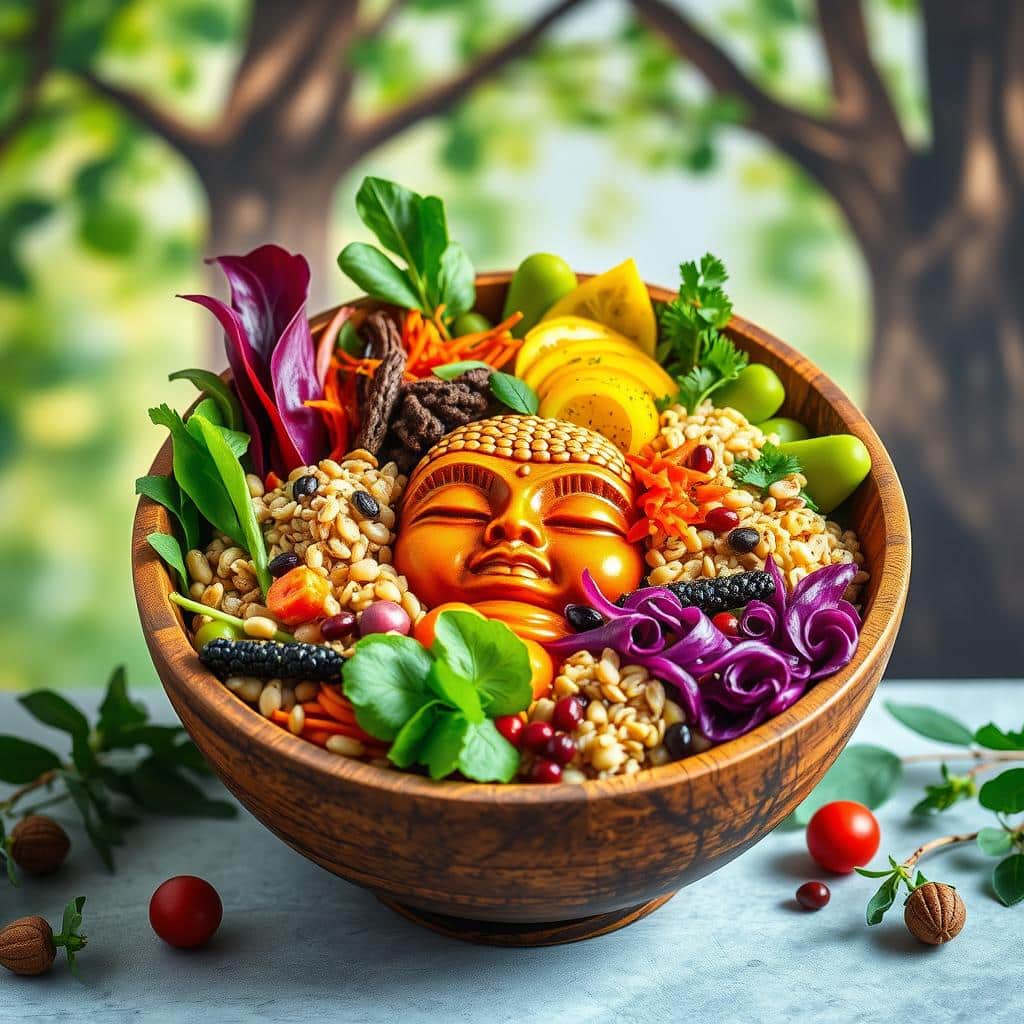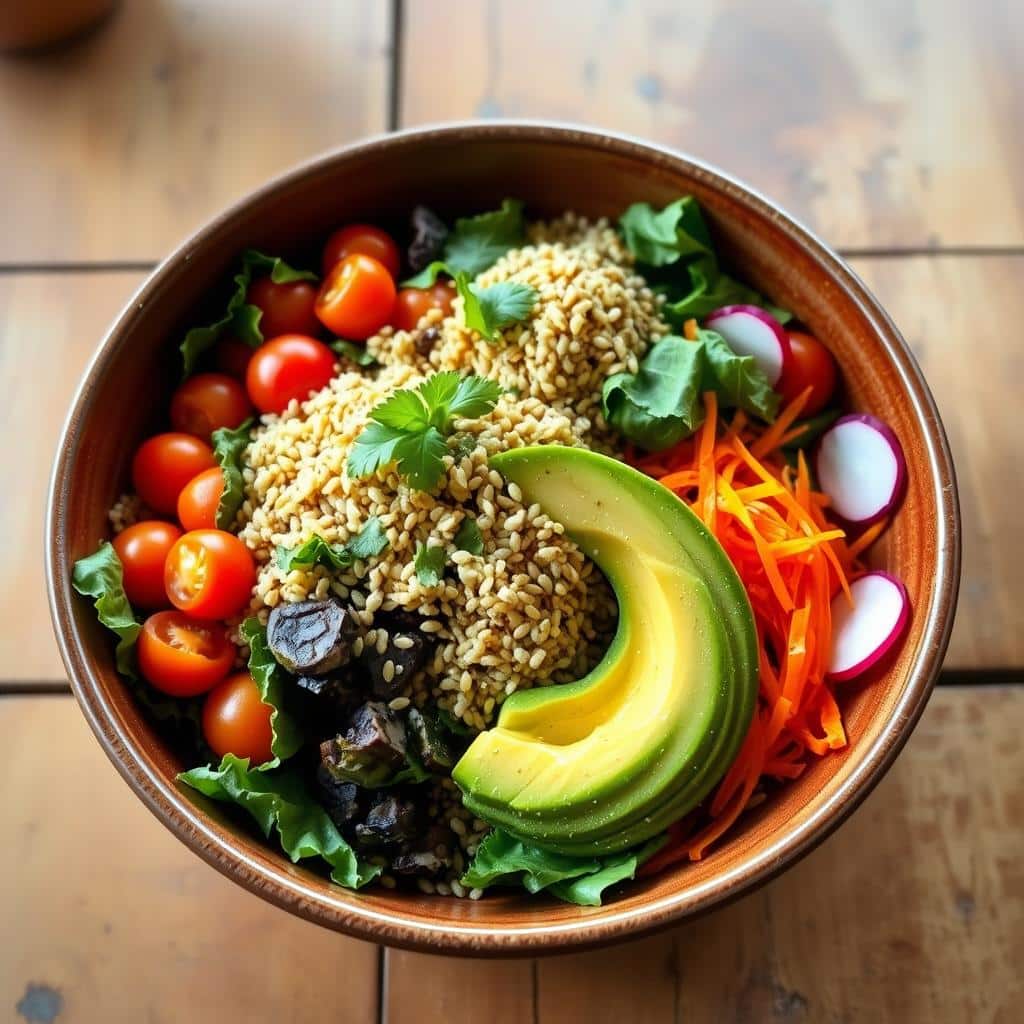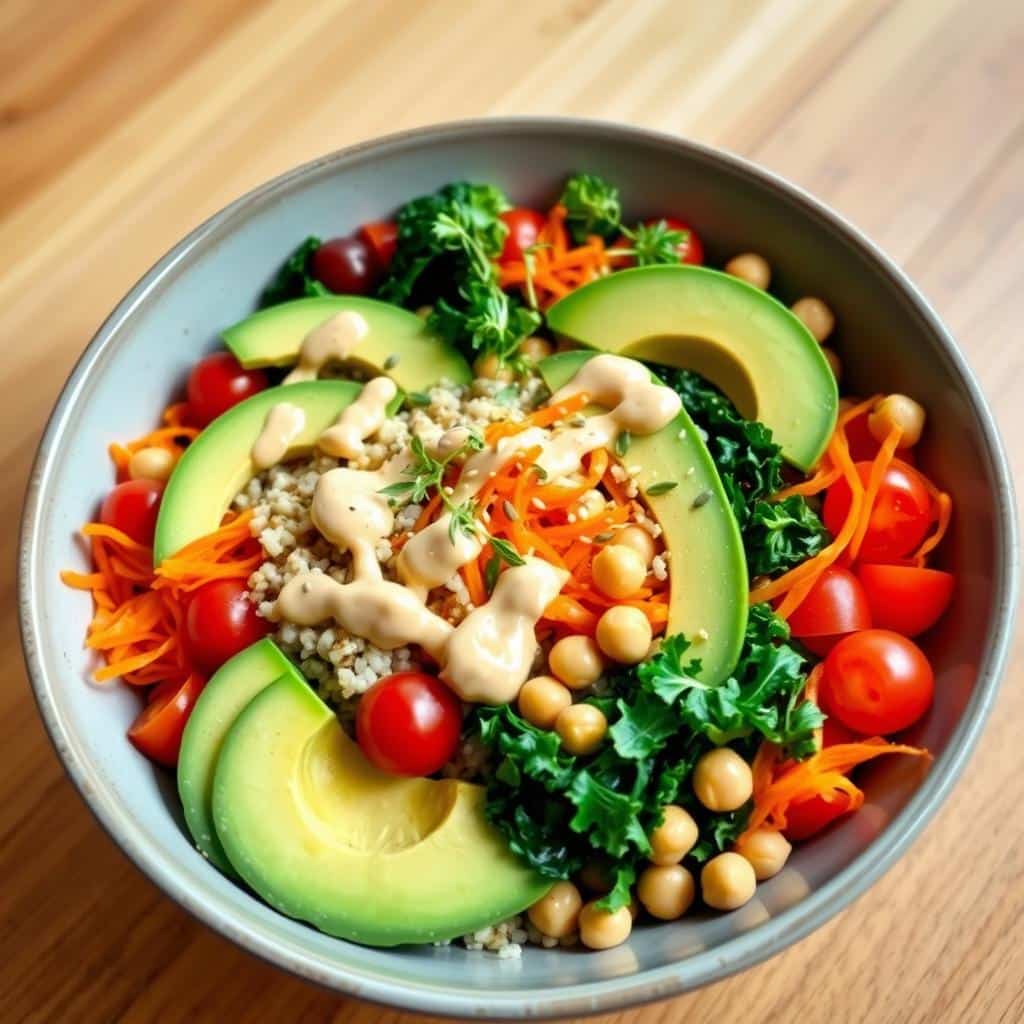As a busy working professional, I often found myself struggling to prepare nutritious meals. That was until I discovered the vegetarian Buddha bowl. This vibrant, plant-based dish nourishes your body and brings calm to your mealtime. Let me share my journey of discovering this culinary delight and how it has changed my approach to healthy eating.
Growing up, I never appreciated the power of whole, unprocessed foods. It wasn’t until I felt the effects of a hectic lifestyle on my health that I realized the importance of nourishing my body. That’s when I found the Buddha bowl, a mix of wholesome grains, roasted vegetables, and plant-based proteins. I was drawn to its vibrant colors, satisfying textures, and promise of a balanced meal.
As I explored Buddha bowls, I was amazed at how easy it was to make a delicious, nutritious meal in under 30 minutes. I no longer relied on processed foods that left me feeling sluggish. Instead, I started exploring seasonal produce, trying different grains, and discovering plant-based proteins. Each Buddha bowl I made was a unique expression of my creativity and a testament to the power of mindful eating.
Key Takeaways
- Vegetarian Buddha bowls are a delicious and nutritious way to incorporate more plant-based foods into your diet.
- These bowls can be prepared in under 30 minutes, making them a convenient option for busy lifestyles.
- Buddha bowls offer a balance of wholesome grains, roasted vegetables, and plant-based proteins, providing a satisfying and nourishing meal.
- Preparing Buddha bowls allows you to explore a variety of seasonal produce and experiment with different flavor combinations.
- Incorporating Buddha bowls into your meal routine can promote overall well-being and a more mindful approach to eating.
What is a Buddha Bowl and Its Cultural Significance
A Buddha bowl, also known as a “power bowl” or “hippie bowl,” is a nutritious and visually appealing dish. It has become popular in buddhist vegetarian and buddhism and vegetarianism cuisine. These bowls feature colorful, plant-based ingredients arranged in a bowl, making for a balanced and satisfying meal.
Origins of Buddha Bowls in Buddhist Cuisine
The Buddha bowl’s origins come from the traditional diets of Buddhist monks. In Buddhist philosophy, mindful eating is highly valued. The act of preparing and eating a meal is seen as a meditative experience.
The traditional Buddhist diet, known as “shojin ryori,” focuses on seasonal, locally-sourced, and meat-free ingredients. These are used to nourish the body and mind.
Modern Interpretation of Traditional Buddhist Food
Modern interpretations of the Buddha bowl have made these traditional practices more accessible. By using a variety of plant-based foods, like grains, vegetables, legumes, and healthy fats, the bowl offers a nutrient-dense and visually appealing meal. This appeals to a wider audience.
“The Buddha bowl is a testament to the power of simple, wholesome ingredients coming together to nourish both the body and the soul.”

The cultural significance of the Buddha bowl is in its ability to connect traditional buddhism and vegetarianism with modern healthy eating trends. It promotes mindful consumption and plant-based nutrition. This makes the Buddha bowl a delicious and sustainable way to explore Buddhist cuisine’s rich culinary heritage.
Essential Ingredients for Your Vegetarian Buddha Bowl
Starting a veggie power bowl means picking the right mix of nutritious vegetarian dishes and plant-based ingredients. It doesn’t matter if you’re new to Buddha bowls or a pro. The goal is to make a meal that’s good for you and tastes great.
Here are the must-haves for a tasty vegetarian Buddha bowl:
- Whole grains like quinoa, brown rice, or farro for carbs and fiber
- Roasted or sautéed vegetables like sweet potatoes, broccoli, and kale
- Protein from plant-based ingredients like chickpeas, tofu, or lentils
- Crunchy toppings like nuts, seeds, or crispy baked tofu
- Flavorful dressings or sauces to bring it all together
Using fresh, nutrient-dense ingredients makes a Buddha bowl that’s both filling and pretty. The fun part is trying out different flavors and textures to find your favorite.

Kitchen Tools and Equipment You’ll Need
To make a tasty vegetarian Buddha bowl, you need the right kitchen tools. From basic utensils to special tools, the right gear makes prep easier. Let’s look at the key kitchen essentials and tools for your dish.
Basic Cooking Utensils
Start with basic cooking tools. You’ll need a strong chef’s knife for chopping, a good cutting board, and mixing bowls. Also, have measuring cups and spoons ready. A vegetable peeler and spatula or tongs are useful too.
Food Prep Equipment
For easier prep, get some special tools. A food processor or blender helps with shredding and blending. A baking sheet or roasting pan is key for roasting veggies. Use a steamer basket or saucepan for cooking grains.
Serving Essentials
For serving, pick the right dishes. Choose a wide, shallow bowl for arranging your bowl’s parts. Use small dishes for dressings and toppings. Reusable utensils like chopsticks or a spoon add to the presentation.
You don’t have to spend a lot to make a great Buddha bowl. Many tools are affordable, and some items do more than one job in the kitchen.
Preparing the Perfect Grain Base
The foundation of any delicious grain bowl is the grain base. From hearty whole grains to fluffy quinoa and nutty brown rice, the right grain can make all the difference in your grain bowls. Let’s explore how to cook up the perfect grain base for your vegetarian Buddha bowl.
Mastering Whole Grain Cooking
When it comes to whole grains, the key is to cook them to the ideal texture – tender yet with a satisfying bite. Here are some tips for cooking whole grains to perfection:
- Use a 1:2 grain-to-water ratio for most whole grains, like quinoa or brown rice.
- Bring the water to a boil, then reduce heat and simmer, covered, until the grains are tender and have absorbed all the liquid.
- For a fluffier texture, fluff the whole grains with a fork after cooking.
- Experiment with different whole grain blends, like a mix of quinoa and brown rice, for added flavor and texture.
Grain Cooking Times
| Grain | Cooking Time |
|---|---|
| Quinoa | 12-15 minutes |
| Brown Rice | 25-30 minutes |
| Farro | 20-30 minutes |
| Bulgur | 10-12 minutes |
Remember, these are general guidelines, and the exact cooking time may vary. It depends on the brand, type, and amount you’re cooking. Always refer to the package instructions for the best results.
With the perfect grain base prepared, you’re one step closer to assembling your delicious vegetarian Buddha bowl. Let’s move on to roasting the seasonal vegetables next.
Guide to Roasting Seasonal Vegetables
Roasting vegetables brings out their natural sweetness and flavor. For a perfect vegetarian Buddha bowl, use fresh, seasonal produce. This ensures great taste and nutrition. Let’s learn how to roast different vegetables for a delicious, balanced dish.
Root Vegetables Preparation
Root veggies like carrots, beets, and potatoes are key in many Buddha bowls. Begin by cutting them into small pieces. Then, toss them with olive oil, vegetable seasoning, salt, and pepper. Spread them on a baking sheet and roast at 400°F (200°C) for 20-25 minutes. They should be tender and caramelized.
Leafy Greens and Fresh Toppings
- Add seasonal produce like kale, spinach, or arugula for extra nutrition. Sauté or steam them to keep their color and crunch.
- Top your roasted veggies with fresh items like avocado, cucumber, or purple cabbage. They add a refreshing crunch.
Seasoning Tips for Maximum Flavor
Seasoning is crucial for enhancing your roasted veggies’ flavor. Try different vegetable seasonings like garlic powder, cumin, or paprika. Start with a small amount and adjust to taste.
By roasting seasonal veggies, you’ll make a tasty and healthy vegetarian Buddha bowl. It’s sure to impress your loved ones.
Vegetarian Buddha Bowl Protein Sources
Creating a nourishing vegetarian Buddha bowl means adding different plant-based proteins. This keeps you full and energized. You can choose from tasty tofu and hearty legumes.
Tofu is a favorite for Buddha bowls. It’s made from soy and can be cooked in many ways. Try baking it into crispy cubes or making a smooth scramble.
Marinating your tofu in a flavorful sauce before cooking adds a lot of taste.
- Tempeh, a fermented soy product, is another great protein source. Slice it thin and cook until crispy.
- Legumes like chickpeas, lentils, and black beans are packed with nutrients. They add texture and heartiness to your bowl.
- Adding roasted nuts and seeds on top gives your bowl a protein boost and a nice crunch.
Choose a variety of textures and flavors for your plant-based proteins. This makes your meatless meal dynamic and satisfying. With a little creativity, your Buddha bowl can be both healthy and delicious.
Creating Flavorful Plant-Based Dressings
The dressing is key in a vegetarian buddha bowl. It can make the whole dish pop. Instead of buying dressings, try making your own vegan dressings. This way, you can add flavors that match the other ingredients perfectly.
Quick Tahini Sauce Recipe
A creamy tahini sauce is great for buddha bowls. It’s full of nutrients and tastes amazing with different bowl elements. To make it, mix tahini, lemon juice, garlic, water, salt, and pepper. You can change the thickness by adding more water.
This homemade sauce adds a rich, nutty taste. It brings everything in the bowl together.
Asian-Inspired Dressing Options
- Try an Asian twist with soy sauce, rice vinegar, sesame oil, ginger, and a bit of maple syrup or honey. This buddha bowl recipe dressing adds a deep flavor to roasted veggies and grains.
- For a miso dressing, mix white or yellow miso paste, water, rice vinegar, and a touch of sweetness from maple syrup or agave.
Homemade vegan dressings let you play with flavors. Use these basic recipes as a starting point. Then, add your favorite herbs, spices, and a bit of acidity to make a unique buddha bowl dressing.
Assembly Tips for Instagram-Worthy Bowls
Making a stunning vegetarian Buddha bowl is more than just mixing ingredients. It’s about how you present it and mix flavors. Follow these tips to make your Buddha bowl a feast for the eyes and taste buds.
Start with a base like quinoa or brown rice. This will be the foundation of your bowl. Then, add your colorful vegetables on top, making sure they look good and feel great. Mix earthy veggies with crisp greens and juicy tomatoes for a pop of color.
- Make your veggies look good by arranging them in a way that catches the eye.
- Add a protein like tofu or chickpeas to give your bowl substance.
- Finish with a plant-based dressing to tie all the flavors together.
- Top it off with fresh herbs, seeds, or microgreens for a final touch.
Creating an Instagram-worthy Buddha bowl is all about taste and looks. Follow these tips to make a dish that’s both healthy and Instagram-perfect.
“Eating with the eyes is just as important as eating with the mouth. A beautiful Buddha bowl not only nourishes the body, but also the soul.”
Nutritional Benefits and Meal Planning
Vegetarian Buddha bowls are not just tasty but also super good for you. They are full of nutrients that help keep your body healthy and full of energy. These meals are packed with the good stuff your body needs to stay strong.
Macro and Micronutrient Breakdown
A vegetarian Buddha bowl is a nutritional powerhouse. Whole grains like quinoa or brown rice give you energy and keep you full. Roasted veggies add vitamins, minerals, and antioxidants, like vitamins A, C, and K, and iron and potassium.
Plant-based proteins, such as tofu or chickpeas, are full of amino acids. These help your muscles recover and grow. So, a Buddha bowl is a complete meal that supports your health.
Meal Prep Strategies
- Prepare the grain base, roasted veggies, and protein components in advance to streamline your meal prep.
- Store the elements separately in airtight containers to maintain their freshness and texture.
- Mix and match the components throughout the week to create a variety of healthy and delicious Buddha bowl combinations.
- Experiment with different dressings and sauces to add flavor and variety to your meals.
Adding vegetarian Buddha bowls to your meal plan can make healthy eating easy and stress-free. These meals are not only good for you but also save you time. They can be a big help in achieving a balanced and nutritious lifestyle.
| Nutrient | Amount per Serving |
|---|---|
| Calories | 450 kcal |
| Protein | 20 g |
| Carbohydrates | 60 g |
| Fiber | 12 g |
| Fat | 15 g |
| Vitamin A | 120% DV |
| Vitamin C | 90% DV |
| Iron | 25% DV |
Vegetarian Buddha bowls are a great choice for meal planning and healthy eating. Knowing what nutrients they offer helps you include them in a balanced diet. This way, you can enjoy the many benefits of these nutrient-dense meals.
Customization Options and Variations
Exploring vegetarian Buddha bowls opens a world of culinary fun. You can adjust them to fit your diet, use seasonal ingredients, or just to keep things interesting. There are countless ways to make your Buddha bowls your own.
Need a gluten-free or low-carb option? Swap the grain base for cauliflower rice or quinoa. For vegans, add roasted chickpeas or marinated tofu for a protein-rich meal.
- Gluten-free: Opt for quinoa, brown rice, or cauliflower rice as the base.
- Low-carb: Use leafy greens like kale or spinach as the base instead of grains.
- Vegan: Incorporate plant-based proteins like roasted chickpeas or marinated tofu.
Seasonal changes bring new flavors to your Buddha bowls. In summer, use fresh veggies. For fall, try roasted root veggies like sweet potatoes and beets. Add a Mediterranean twist with feta, olives, and lemon dressing. Or go Asian with edamame, sesame seeds, and teriyaki sauce.
| Variation | Key Ingredients | Dressing Suggestion |
|---|---|---|
| Mediterranean | Quinoa, feta, kalamata olives, roasted red peppers | Lemon-tahini dressing |
| Asian-Inspired | Brown rice, steamed edamame, shredded carrots, toasted sesame seeds | Teriyaki-ginger dressing |
| Autumn-Inspired | Roasted sweet potatoes, Brussels sprouts, quinoa | Maple-balsamic vinaigrette |
Buddha bowls are all about flexibility. Mix and match ingredients and flavors to make meals that are just right for you. This way, you can keep your taste buds happy and your body nourished.
Conclusion
You’ve learned how to make tasty and healthy vegetarian Buddha bowls at home. These dishes are great for a vegetarian lifestyle. They also help us eat more sustainably and enjoy plant-based cuisine.
Whether you’re already a vegetarian or want to eat more plant-based meals, Buddha bowls are perfect. They’re easy to make, full of flavor, and good for you. By layering grains, roasted veggies, proteins, and dressings, you can make a bowl that’s both beautiful and delicious.
Keep exploring your vegetarian lifestyle by trying new things in your Buddha bowls. Try different grains, find fresh veggies, and get creative with proteins and dressings. There’s no limit to what you can make, and it’s all about enjoying healthy food.
FAQ
What is a Buddha bowl and what is its cultural significance?
A Buddha bowl, also known as a power bowl or grain bowl, is a nutritious dish. It comes from Buddhist cuisine. These bowls have whole grains, vegetables, proteins, and toppings.
The cultural significance of Buddha bowls is in their Buddhist roots. They focus on fresh, seasonal produce and balanced eating.
What are the essential ingredients for a vegetarian Buddha bowl?
A vegetarian Buddha bowl needs a whole grain base like quinoa or brown rice. It also has roasted or sautéed vegetables, a protein source, and toppings like seeds and nuts.
The goal is to make a meal that looks good and is balanced. It should have all the nutrients you need.
What kitchen tools and equipment do I need to prepare a Buddha bowl?
To make a Buddha bowl, you’ll need basic cooking tools. This includes a knife, cutting board, and mixing bowls.
Also, a sheet pan for roasting, a saucepan for grains, and a blender for dressings are helpful. Serving it in a wide bowl makes it look better.
How do I select and cook the perfect grain base for my Buddha bowl?
Choosing the right grain is key for a good Buddha bowl. Options include quinoa, brown rice, and farro. Follow the package instructions for cooking.
Try different grains to add variety and flavor to your bowls.
What are some good vegetarian protein sources for a Buddha bowl?
There are many vegetarian proteins for Buddha bowls. Tofu, tempeh, lentils, and nuts are good choices. Marinate, bake, or sauté them for flavor and texture.
Using different proteins makes your meal balanced and satisfying.
How can I make flavorful plant-based dressings for my Buddha bowl?
Creating tasty plant-based dressings can enhance your Buddha bowl. Try tahini sauce, lemon-herb vinaigrette, or sesame-ginger dressing. Use nut butters, citrus, herbs, and spices for flavor.
These dressings can bring all the flavors together.
What are some tips for assembling an Instagram-worthy Buddha bowl?
To make a Buddha bowl look good, arrange ingredients nicely. Use colors and patterns. Add height with avocado or roasted vegetables.
Garnish with fresh herbs, nuts, or dressing for extra appeal.
What are the nutritional benefits of a vegetarian Buddha bowl?
Vegetarian Buddha bowls are full of nutrients. They have fiber, vitamins, and minerals from vegetables and grains. They also have plant-based fats and antioxidants.
These bowls are a healthy and filling meal choice.
How can I customize and vary my Buddha bowl recipes?
Buddha bowls are versatile and easy to customize. Try different grains, vegetables, and proteins for new flavors. You can make Mediterranean, Mexican, or Asian bowls.
Adjust ingredients for dietary needs or preferences. This makes Buddha bowls inclusive and flexible.

